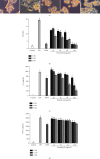Chemical Composition, Antibacterial, and Anti-Inflammatory Activities of Essential Oils from Flower, Leaf, and Stem of Rhynchanthus beesianus
- PMID: 33997008
- PMCID: PMC8102109
- DOI: 10.1155/2021/5562461
Chemical Composition, Antibacterial, and Anti-Inflammatory Activities of Essential Oils from Flower, Leaf, and Stem of Rhynchanthus beesianus
Abstract
Rhynchanthus beesianus is a medicinal, ornamental, and edible plant, and its essential oil has been used as an aromatic stomachic in China. In this study, the chemical constituents, antibacterial, and anti-inflammatory properties of flower essential oil (F-EO), leaf essential oil (L-EO), and stem essential oil (S-EO) of R. beesianus were investigated for the first time. According to the GC-FID/MS assay, the F-EO was mainly composed of bornyl formate (21.7%), 1,8-cineole (21.6%), borneol (9.7%), methyleugenol (7.7%), β-myrcene (5.4%), limonene (4.7%), camphene (4.5%), linalool (3.4%), and α-pinene (3.1%). The predominant components of L-EO were bornyl formate (33.9%), borneol (13.2%), 1,8-cineole (12.1%), methyleugenol (8.0%), camphene (7.8%), bornyl acetate (6.2%), and α-pinene (4.3%). The main components of S-EO were borneol (22.5%), 1,8-cineole (21.3%), methyleugenol (14.6%), bornyl formate (11.6%), and bornyl acetate (3.9%). For the bioactivities, the F-EO, L-EO, and S-EO exhibited significant antibacterial property against Bacillus subtilis, Enterococcus faecalis, Staphylococcus aureus, Proteus vulgaris, Pseudomonas aeruginosa, and Escherichia coli with the inhibition zones (7.28-9.69 mm), MIC (3.13-12.50 mg/mL), and MBC (6.25-12.50 mg/mL). Besides, the F-EO, L-EO, and S-EO significantly inhibited the production of proinflammatory mediator nitric oxide (NO) (93.15-94.72%) and cytokines interleukin-6 (IL-6) (23.99-77.81%) and tumor necrosis factor-α (TNF-α) (17.69-24.93%) in LPS-stimulated RAW264.7 cells at the dose of 128 μg/mL in the absence of cytotoxicity. Hence, the essential oils of R. beesianus flower, leaf, and stem could be used as natural antibacterial and anti-inflammatory agents with a high application potential in the pharmaceutical and cosmetic fields.
Copyright © 2021 Qi Chen et al.
Conflict of interest statement
The authors declare that they have no conflicts of interest.
Figures





Similar articles
-
Chemical Composition, Antibacterial, Anti-Inflammatory, and Enzyme Inhibitory Activities of Essential Oil from Rhynchanthus beesianus Rhizome.Molecules. 2020 Dec 31;26(1):167. doi: 10.3390/molecules26010167. Molecules. 2020. PMID: 33396533 Free PMC article.
-
Hedychium flavum flower essential oil: Chemical composition, anti-inflammatory activities and related mechanisms in vitro and in vivo.J Ethnopharmacol. 2023 Jan 30;301:115846. doi: 10.1016/j.jep.2022.115846. Epub 2022 Oct 22. J Ethnopharmacol. 2023. PMID: 36280015
-
Chemical Composition and Antimicrobial Activity of Laurus nobilis L. Essential Oils from Bulgaria.Molecules. 2019 Feb 22;24(4):804. doi: 10.3390/molecules24040804. Molecules. 2019. PMID: 30813368 Free PMC article.
-
Essential Oils of Duguetia Species A. St. Hill (Annonaceae): Chemical Diversity and Pharmacological Potential.Biomolecules. 2022 Apr 21;12(5):615. doi: 10.3390/biom12050615. Biomolecules. 2022. PMID: 35625543 Free PMC article. Review.
-
Phytochemistry, Bioactivities and Traditional Uses of Michelia × alba.Molecules. 2022 May 26;27(11):3450. doi: 10.3390/molecules27113450. Molecules. 2022. PMID: 35684387 Free PMC article. Review.
Cited by
-
Linalool-based silver nanoconjugates as potential therapeutics for glioblastoma: in silico and in vitro insights.PLoS One. 2025 Jun 12;20(6):e0325281. doi: 10.1371/journal.pone.0325281. eCollection 2025. PLoS One. 2025. PMID: 40504869 Free PMC article.
References
-
- Buchbauer G., Bohusch R. Biological activities of essential oils: an update. In: Baser K. H. C., Buchbauer G., editors. Handbook of Essential Oils: Science, Technology, and Applications. Boca Raton, USA: CRC Press/Taylor & Francis Group; 2010. pp. 281–321.
-
- Raut J. S., Karuppayil S. M. A status review on the medicinal properties of essential oils. Industrial Crops and Products. 2014;62:250–264. doi: 10.1016/j.indcrop.2014.05.055. - DOI
-
- The Plant List, Version 1.1. December 2020, http://www.theplantlist.org/1.1/browse/A/Zingiberaceae/
MeSH terms
Substances
LinkOut - more resources
Full Text Sources
Other Literature Sources
Medical
Molecular Biology Databases
Miscellaneous

